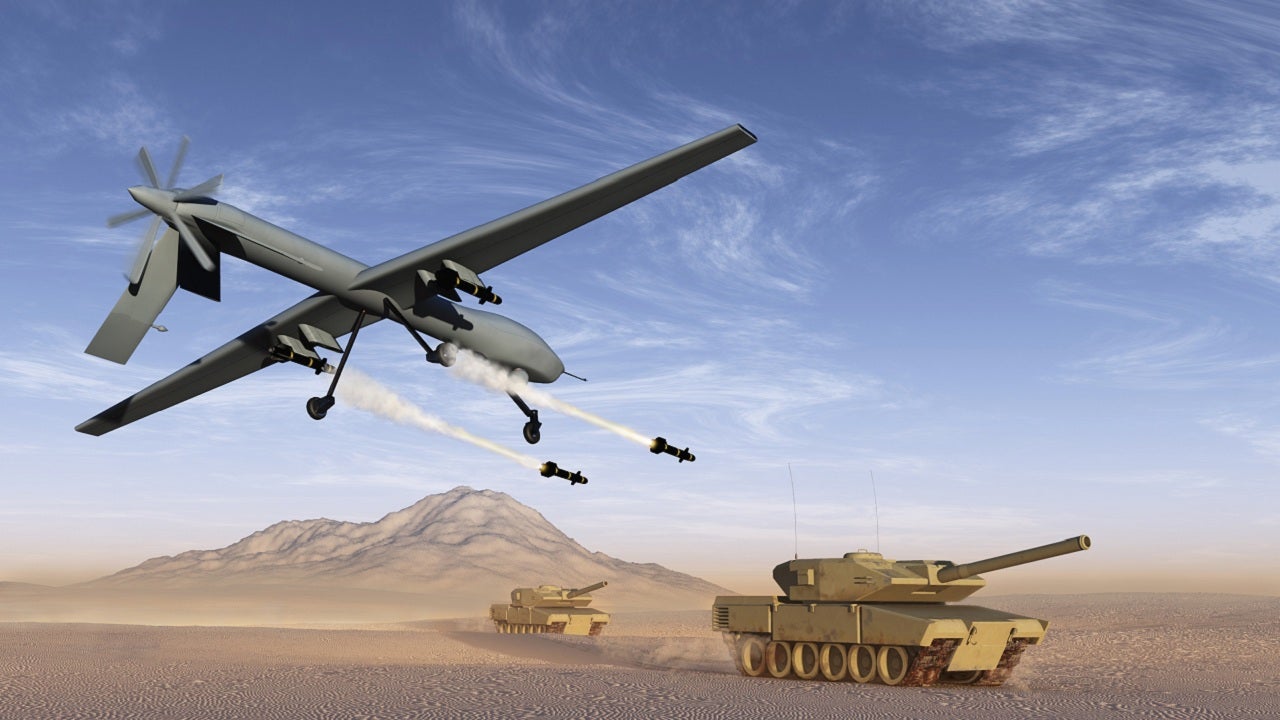
Top Russia’s Long-Range Attack Drones Strikers
Russia is accelerating the development of multiple long-range attack UAVs to compete with the US and China who are ahead in the combat drone race.
Army Technology lists the top five of Russia’s long-range attack drones under development, based on their technical specifications.
Sukhoi S-70 Okhotnik-B (Hunter)

The S-70 Okhotnik-B (Hunter) is a stealth-capable combat drone being developed by Sukhoi Design Bureau and Russian Aircraft Corporation MiG. The drone made its first flight in August 2019. The unmanned combat aerial vehicle (UCAV) is expected to be delivered to the Russian armed forces in 2024.
Anticipated to serve as a ‘loyal wingman’, the stealthy drone incorporates a flying wing design, while its composite fuselage is covered with the radar-absorbing paint. It is designed to offer a lower radar cross-section. Powered by an AL-31 turbojet engine, the UCAV can be installed with electro-optical targeting, communication, and reconnaissance payloads.
With the maximum take-off weight of 20t, the Okhotnik-B combat drone is significantly bigger than its Western counterparts such as Dassault nEUROn and Northrop Grumman X-47B. The length and wingspan of the Hunter UCAV are 14m and 20m, respectively.
The attack drone features two internal weapon bays to accommodate up to 2,000kg of guided and unguided munitions, including air-to-surface missiles and bombs. It is expected to fly at a speed of 1,000km/h and attain a maximum range of 6,000km.

US Tariffs are shifting - will you react or anticipate?
Don’t let policy changes catch you off guard. Stay proactive with real-time data and expert analysis.
By GlobalDataGrom (Thunder)
Grom (Thunder) is a new stealth combat drone designed by Kronstadt. A mock-up of the UAV was presented during the Army-2020 trade show held in Moscow, in August 2020. The Thunder UCAV is intended to operate, along with the Su-35 and Su-57 fighter aircraft, to provide reconnaissance data and fire missiles upon receiving commands from the manned jet.
With its dorsal inlet and V-shape tail, Russia’s long-range attack drone bears a striking resemblance to the Kratos XQ-58 Valkyrie stealthy unmanned combat aerial vehicle. The Grom combat UAV measures 13.8m-long and 3.8m-high while its wingspan is 10m.
The drone has a maximum take-off weight of 7t and can carry a maximum payload of 2,000kg. It has four hard-points including two under the wing consoles and two inside the fuselage. It can carry Izdeliye 85, KAB-250-LG-E, KAB-500S-E, and X-38MLE munitions.
The stealthy drone can fly at a cruise speed of 800km/h and reach a maximum altitude of 12,000m. It has a maximum speed of approximately 1,000km/h, while the combat radius of the UAV is 700km.
Altius-U

The Altius-U medium altitude long endurance (MALE) drone is being developed by Ural Civil Aviation Plant (UZGA). The attack and reconnaissance capabilities of the drone are believed to be comparable to that of RQ-9 Reaper and RQ-4 Global Hawk UAVs.
The Altius-U MALE UAV made its first flight in August 2019. It flew for 32 minutes at a maximum altitude of 800m in fully autonomous mode. The drone is expected to perform reconnaissance, strike and electronic attack missions for the Russian Air Force and Navy.
The fixed-wing design of the unmanned aerial vehicle incorporates a large high-mounted wing, a V-tail configuration and a three-leg retractable landing gear. Built using the composite materials, Altius is powered by two new VK-800C turboprop engines developed by the Klimov Design Bureau.
The 7t drone can carry 2t of combat payload, including a family of Grom 9-A-7759 gliding bombs which can engage targets at a distance of 120km. The drone can target headquarters, radars, missile and air defence units and land-based cruise missile launchers while supporting low-intensity conflicts and counter-terrorism operations.
Kronstadt Sirius

The Sirius medium-altitude long-endurance (MALE) attack UAV from Kronstadt is touted to be the biggest Russian drone with a wingspan of 30m. It is intended to support the surveillance missions at the borders and the Russian exclusive economic zone (EEZ) in the Arctic and the Pacific.
A full-size mock-up of the 5t drone was presented for the first time at the MAKS-2019 International Aviation and Space Salon held at Zhukovsky International Airport near Moscow, Russia. It was also on display at the Army-2020 international military-technical forum held in August 2020.
The long-range reconnaissance and attack drone will have a length of 9m and a height of 3.3m. It will also feature a satellite communications complex, allowing it to perform long-range reconnaissance and combat missions.
The drone will have the capacity to carry a maximum combat load of 450kg, allowing it to carry guided bombs or air-to-ground missiles. It will cruise at a speed of 295km/h and fly at an altitude of 12,000m. The endurance of the Sirius UAV with full payload will be 40 hours.
Kronshtadt Orion

Orion is a medium-altitude combat-capable UAV developed by Kronstadt, a part of Sistema JSFC. Kronstadt showcased the Orion drone, along with a full range of weapons, during the Army-2020 defence exhibition held in August 2020.
The fixed-wing design of the Orion drone integrates V-shaped tail fins. The drone is made of carbon plastic composite materials to reduce the weight of fuselage. It is also equipped with an electric impulse anti-icing system for operation in low temperatures.
The drone can carry four guided bombs or four missiles, including the KAB-50 bombs and UPAB-50S 50kg guided munitions. The UPAB-50S missile can strike personnel and objects at a maximum distance of 30km. It can be attached with high-explosive (HE) fragmentation, cluster, and fuel-air explosive warhead types. The combat UAV is also installed with a new weapon guidance system.
The Orion UAV has a maximum speed of 200km/h while its maximum flight duration with the standard payload is 24 hours. Orion-E, the export version, has a maximum take-off weight of 1,000kg and can carry a 200kg payload, including four 50kg or two 100kg munitions.



